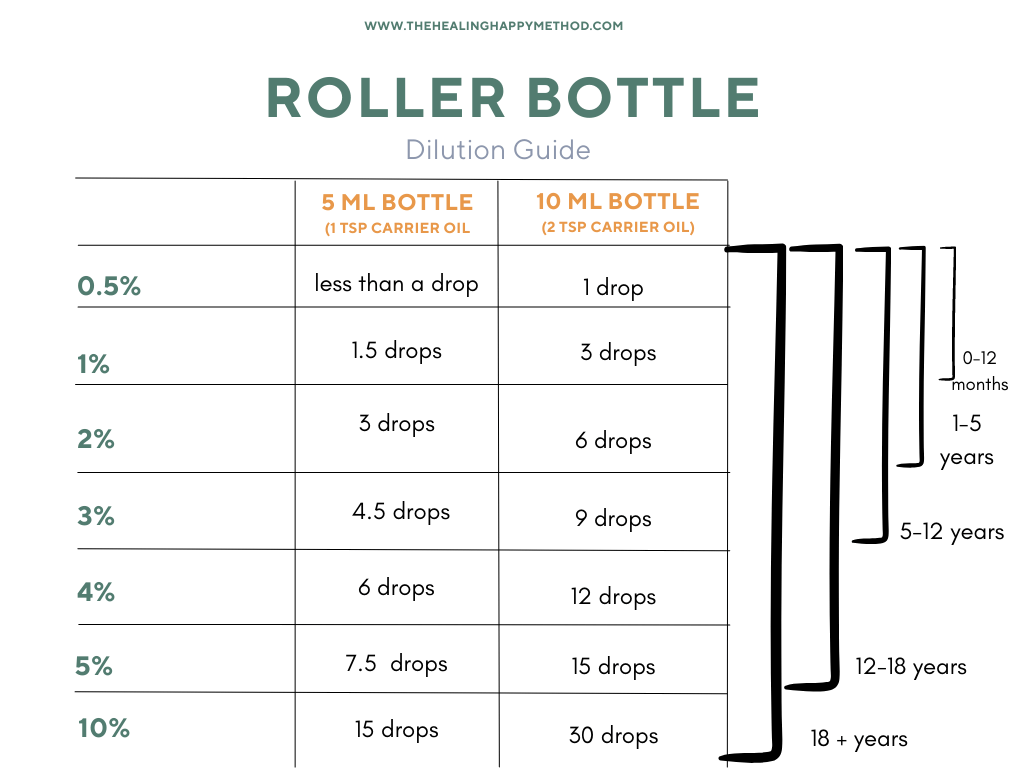Making your own essential oil products can save you money, and it can be a fun DIY project, but you need to make sure that you are diluting the oils safely.
Essential oils are concentrated and can cause irritation to the skin. Properly diluting the oils is the best way to keep you and your family safe.
Here are 4 reasons why you should always dilute essential oils for topical use:
- prevents dryness
- slows down evaporation
- prevents adverse skin reactions
- prevents toxicity
In order to dilute essential oils for the skin, you need a carrier.
A carrier is simply a solution that “carries” the essential oil to the skin safely.
Generally speaking, liquid oils (aka carrier oils), are the best way to dilute essential oils.
Here are a few carrier oils to choose from:
- Almond oil
- Apricot kernel oil
- Argan oil
- Avocado oil
- Coconut oil
- Evening primrose oil
- Grapeseed oil
- Hemp seed oil
- Jojoba oil
- Macadamia nut oil
- Olive oil
- Pomegranate seed oil
- Rosehip oil
- Sesame Oil
Other Essential Oil Carriers
In addition to oils, you can also dilute essential oils in butters like:
- Shea butter
- Mango butter
- Kokum butter
- Cocoa butter
However, keep in mind that butters are quite heavy.
So, you may end up absorbing less essential oils when you use mostly heavy butters.
Lastly, you can also dilute essential oils in:
- lotions
- creams
- castile soap
- shampoos
- aloe vera jelly
ESSENTIAL OIL DILUTION RATIO CHART
Now it’s time to talk about the most critical aspect of essential oil dilution: the dilution rate.
The dilution rate tells you the concentration of essential oils in your blend.
So, let’s say you mix lavender oil and coconut oil in a 1% dilution.
That means 1% of the blend contains lavender oil.
For topical application, a dilution of 0.5 to 5% works for most people.
As you’ve probably guessed already, the higher the dilution rate, the higher the essential oil concentration.
To figure out what you need for each dilution level, use the essential oil dilution ratio chart below.
Note: if you’re reading this on a mobile device, simply swipe left/right on the table to view all columns.
| 10ml |
15ml (½ oz) |
20ml |
30ml (1 oz) |
50ml |
60ml (2 oz) |
|
| 0.5% | 1 drop | 2 drops | 3 drops | 4 drops | 7 drops | 8 drops |
| 1% | 3 drops | 4 drops | 6 drops | 9 drops | 15 drops | 18 drops |
| 2% | 6 drops | 9 drops | 12 drops | 18 drops | 30 drops | 36 drops |
| 3% | 9 drops | 13 drops | 18 drops | 27 drops | 45 drops | 54 drops |
| 4% | 12 drops | 18 drops | 24 drops | 36 drops | 60 drops | 72 drops |
| 5% | 15 drops | 22 drops | 30 drops | 45 drops | 75 drops | 90 drops |
| 8% | 24 drops | 36 drops | 48 drops | 72 drops | 120 drops | 144 drops |
| 10% | 30 drops | 44 drops | 60 drops | 90 drops | 150 drops | 180 drops |
| 20% | 60 drops | 88 drops | 120 drops | 180 drops | 300 drops | 360 drops |
10ml, 15ml and so on refer to the amount of carrier oil. These numbers also match up with the sizes of cosmetic bottles that are sold in stores and online (which are usually represented in ml).

With so many dilutions levels, how do you know what to use?
Here are some general guidelines:
- 1% or less: for pregnancy, small children and face.
- 2%: regular daily use
- 3 – 10%: for treating acute conditions or injury for a short period of time (about 2 weeks)
HOW TO DILUTE ESSENTIAL OILS FOR SKIN AND HAIR
When using essential oils on the skin a dilution rate of 0.5 to 5% is safest for regular, every day use.
Now, having said that, there are times when you might need a higher dilution.
For example, if you’re healing from a burn or fighting an infection.
Based on information from the Tisserand Institute, use the guidelines below to determine the dilution level that works for your needs.
| USE | DILUTION LEVEL |
| Face products | 0.2 – 1.5% |
| Whole body massage | 1.5 – 3% |
| Bath and body products | 1 – 4% |
| Specific problems | 4 – 10% |
| Pain and wounds | 5 – 20% |
Remember that with essential oils, less is more.
So, start with the lowest dilution for your needs. If you don’t get the desired results, you can steadily increase the dilution level.
Once you’ve figured out your intended use and the recommended dilution, you should also make sure that the oils you have are actually safe for the skin.
The table below shows the oils that are known to cause skin irritation and allergic reactions.
You don’t have to completely avoid topical use of these oils.
However, it’s important to follow the maximum dilutions listed below:
| OIL | TOPICAL MAXIMUM |
| Ajowan | 1.4% |
| Bay oil | 0.9% |
| Cassia | 0.05% |
| Clove Bud | 0.5% |
| Cinnamon bark | 0.1% |
| Cinnamon leaf | 0.6% |
| Garlic oil | 0.1% |
| Holy basil | 1% |
| Jasmine absolute | 0.7% |
| Lemongrass | 0.7% |
| Lemon myrtle | 0.7% |
| Lemon-scented tea tree | 0.8% |
| Massoia | 0.01% |
| May chang | 0.8% |
| Melissa | 0.9% |
| Opoponax | 0.6% |
| Oregano | 1.1% |
| Oakmoss absolute | 0.1% |
| Peru balsam | 0.4% |
| Summary savory | 1.4% |
| Thyme | 1.3% |
| Winter savory | 1.2% |
| Ylang ylang | 0.8% |
Essential Oil Dilution For The Face
As we saw in the essential oil dilution chart, a 0.2% to 1.5% dilution is recommended for face products.
This means that whether you’re making your own face oil, anti-aging serum or face mask, you should always go with a 0.2% to 1.5% dilution.
Some of the essential oils that are effective and gentle enough for the face are:
- lavender oil
- frankincense oil
- juniper berry oil
- geranium oil
- tea tree oil
- myrrh oil
- rose oil
- sandalwood oil
- chamomile oil
- copaiba oil
- peppermint oil
Essential Oil Dilution For Hair
Essential oils can be mixed with shampoos, conditioners and other hair oils to:
- stimulate growth
- reduce hair loss
- fight dandruff
- treat dry hair
When you make an essential oil blend for hair, remember that your scalp is an extension of your skin.
And it’s also quite easy for anything that is applied onto the scalp to absorb into the brain.
So, when you dilute essential oils for hair, follow the same dilution guidelines as you would for your face (0.2 – 1.5% dilution).
Some oils that are great for hair growth and overall hair health include:
- rosemary oil
- peppermint oil
- tea tree oil
- sandalwood oil
- lavender oil
- geranium oil
- clary sage oil
- chamomile oil
- cedarwood oil
Essential Oil Dilution For Bath
The first thing to note about essential oil baths is that essential oils do not mix with water.
So, never add essential oil directly into your bath water.
Secondly, do not use milk, salts or baking soda as a carrier for essential oil in a bath.
This is because all three of the above substances dissolve in water and the essential oils will separate out from them.
Instead follow one of the following recommendations:
- Mix 5 – 20 drops of essential oils in 1 tablespoon of jojoba or fractionated coconut oil. This mixture won’t mix with the water. Instead, it will float above the bath water. It’s greasy, but protects your skin!
- Combine 5 – 20 drops of essential oil with 1 tablespoon liquid castile soap. Add the mixture to your bath water. No greasy mess to worry about in this case 🙂
HOW TO DILUTE ESSENTIAL OILS FOR BABIES, YOUNG CHILDREN AND TEENS
Compared to adults, young children (and babies, especially) have thinner skin that absorbs substances more easily.
Therefore, it’s important to follow the dilution and safety guidelines shown below.
| AGE | RECOMMENDED DILUTION |
| 0 – 3 months | 0.2% or less |
| 3 – 24 months | 0.25 – 0.5% |
| 2 – 6 years | 1 – 2% |
| 6 – 15 years | 1.5 – 3% |
HOW TO DILUTE ESSENTIAL OILS WITH ALOE VERA
Aside from carrier oils, aloe vera is another carrier option for essential oils.
Just keep the following in mind when using aloe vera for essential oil dilution:
- since fresh aloe gel from the plant is mostly water, it’s not ideal for essential oil dispersion. So instead, use an aloe jelly product that has been blended with a thickening agent. That thickening agent helps to better disperse the oil.
- use the same dilution guidelines as you would for carrier oils.
- since aloe has a sticky consistency, it’s best for spot treatments.
- avoid using aloe vera gel on serious burns or heavily infected wounds because it traps heat, which can worsen the problem.
RELATED QUESTIONS
How do you dilute essential oils to make sprays?
To make a face spray, blend 7 drops essential oil with 1 ounce of water and a dispersing agent (such as witch hazel). The dispersing agent allows you to emulsify water and oil together.
CONCLUSION
Even though there are some essential oils that you can use without dilution, knowing how to dilute essential oils will actually give you better results.
I hope this guide was helpful and that you now feel confident to move ahead with some essential remedies of your own.
If you have any questions or feedback about anything in this post, drop a comment below! 🙂


